They can also improve operational efficiency and provide insights for executives to make better decisions, faster.
Here are the top 8 use cases of our API and how you can leverage actionable SEO and website data in a jiffy.
Reporting is by far the biggest use case of our API. It is ideal for:
- Building executive dashboards
- Creating visuals for internal reports
- Creating scorecards
- Monitoring your search visibility for key segments
- Monitoring website health over time
You can warehouse the data yourself and mix it with other sources, or you can visualize it with business intelligence tools like Tableau, Power BI, or even just Google Sheets.
For example, we use the API to pull referring domain data for our blog and aggregate by author. We have some nice little sparklines to visualize growth (or decline), too.

We also combine referring domain data with data from other sources like GSC.
For example, this view shows us actual traffic data from GSC alongside the number of followed DR40+ referring domains for each post:
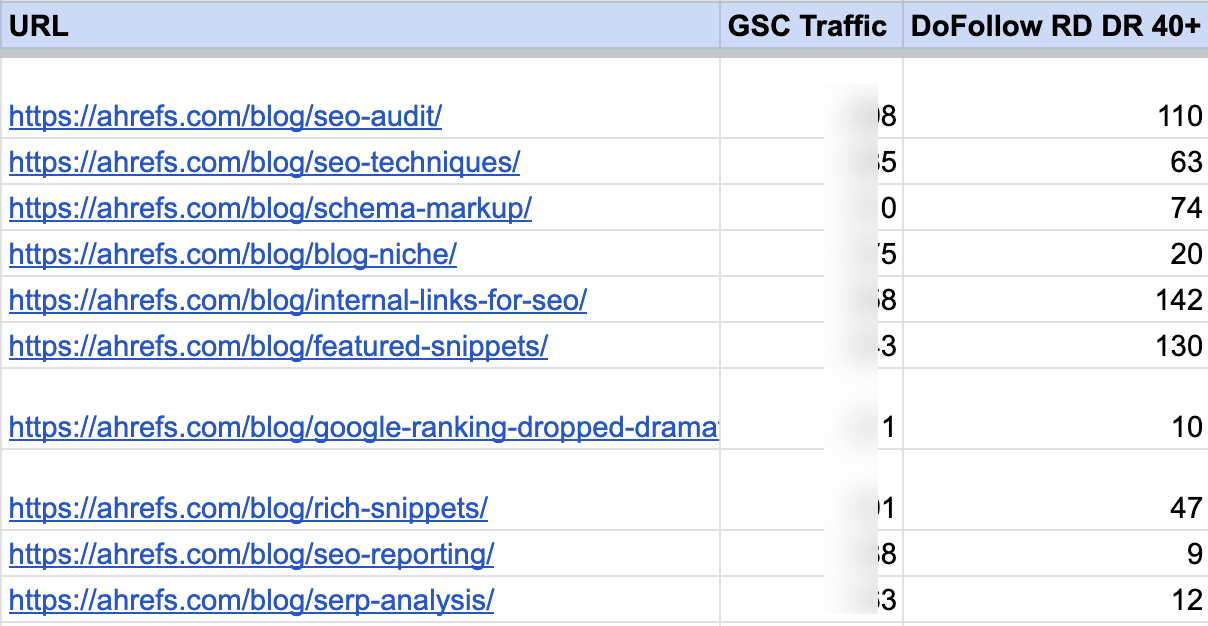
No matter what reporting tools you use internally, we’ve made it easy to integrate many Ahrefs graphs and visuals directly into your dashboard so you can build similar reports.
Just use this nifty API button in any report with data that you’d like to pull into your internal dashboards:

The true power of using our API for reporting is how it helps you keep your finger on the pulse of every area of your business so you can make better decisions faster.
We recommend building reports to monitor the performance of the following:
- Each of your business units
- Different product lines and services
- Custom segmentation
- Individual authors and contributors
It’s the best way to identify underperforming or underresourced products and teams. These dashboards can also help you get SEO buy-in from executives so they approve new projects or budget increases.
If you ever need to pull big SEO data and mix it however you like, our API is the tool for the job. It can help with:
- Large-scale SEO analysis
- Enterprise audits
- Data studies
- SEO testing
- Content inventory creation
- Building outreach lists
- And more
As with most APIs, the best part is that you can pull the data into almost any tool you’re already working with.
For example, say you have a massive list of websites for which you want to pull metrics like Domain Rating (DR). You can do this for up to 200 websites with Batch Analysis—but you can pull the metric for as many URLs as you like with the API.
Here’s a simple example in Google Sheets:

Alternatively, say you want to enrich your content inventory by pulling the keyword data. Specifically, the keyword sending the most organic traffic to each URL, its ranking position, and the estimated traffic it sends. The API makes it possible to do this at the touch of a button.

These are overly simple examples. You can pull as much or as little data as you want to suit pretty much any requirements. You can even mix and match data from Site Explorer, Site Audit, Keywords Explorer, and Rank Tracker.
The true power of an API kicks in when you automate strategic tasks that cannot easily be scaled manually and can be done better when you automate them.
It’s the secret to taking your strategies to the next level, especially for enterprise SEO projects.
For instance, you can automate many link building workflows like triggering alerts and actions based on discovering new or lost links.

You can also automate technical workflows like finding pages to redirect. On large websites, this can be an overwhelming task to do manually. A simple workflow you can consider instead might look like:

The opportunities for automated workflows that harness our SEO API really are endless. We’ve seen folks use our API to:
- Pull keywords into internal systems and tag them based on products, services, locations, or business units they relate to.
- Pull domain metrics for domain buying.
- Combine SEO data with Google Ads data to lower ad costs.
- And so much more.
Many agency sales teams, digital investors, and B2B business development managers use our API data to assist with things like:
- Lead scoring and enrichment
- Qualifying prospects
- Finding advertising partners
- Doing due diligence on companies
For example, let’s say you’re evaluating the following companies as prospects for a new marketing product or service you’re launching.
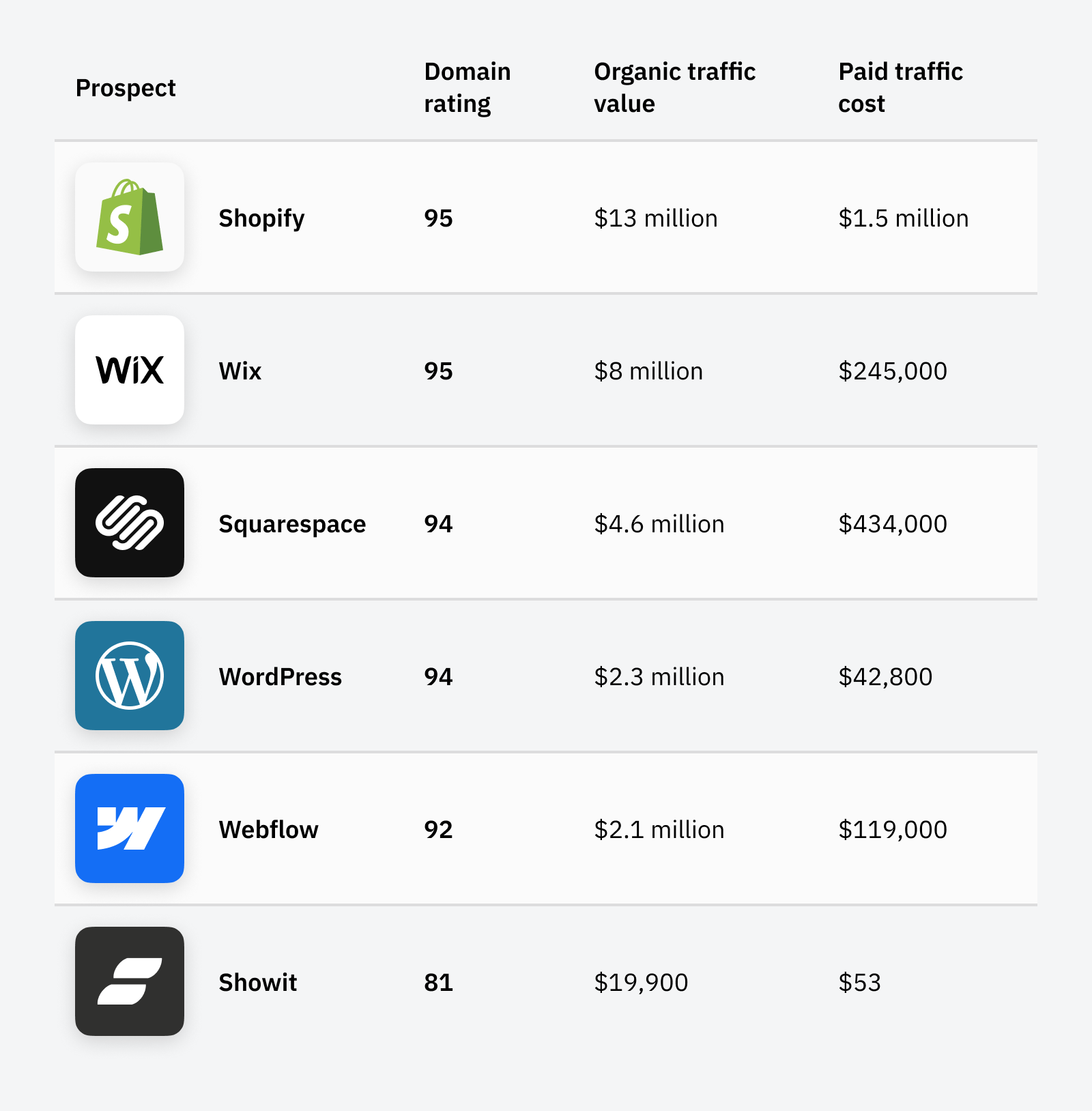
In this example, we’ve pulled the following website metrics to help score these prospects:
- Domain Rating (DR) can help determine the size and authority of a prospect’s company.
- Organic Cost can indicate a website’s size and visibility potential.
- Paid Cost can help indicate the current budget a company is investing in Google Ads.
Depending on what your ideal customer looks like, you can score these prospects in a few different ways using these three metrics alone.
For instance, you can favor indicators of underperformance if you sell a service that can help close a performance gap:

Or if you offer a high-ticket product or service, you can qualify prospects based on indicators of business size or the size of their budgets:
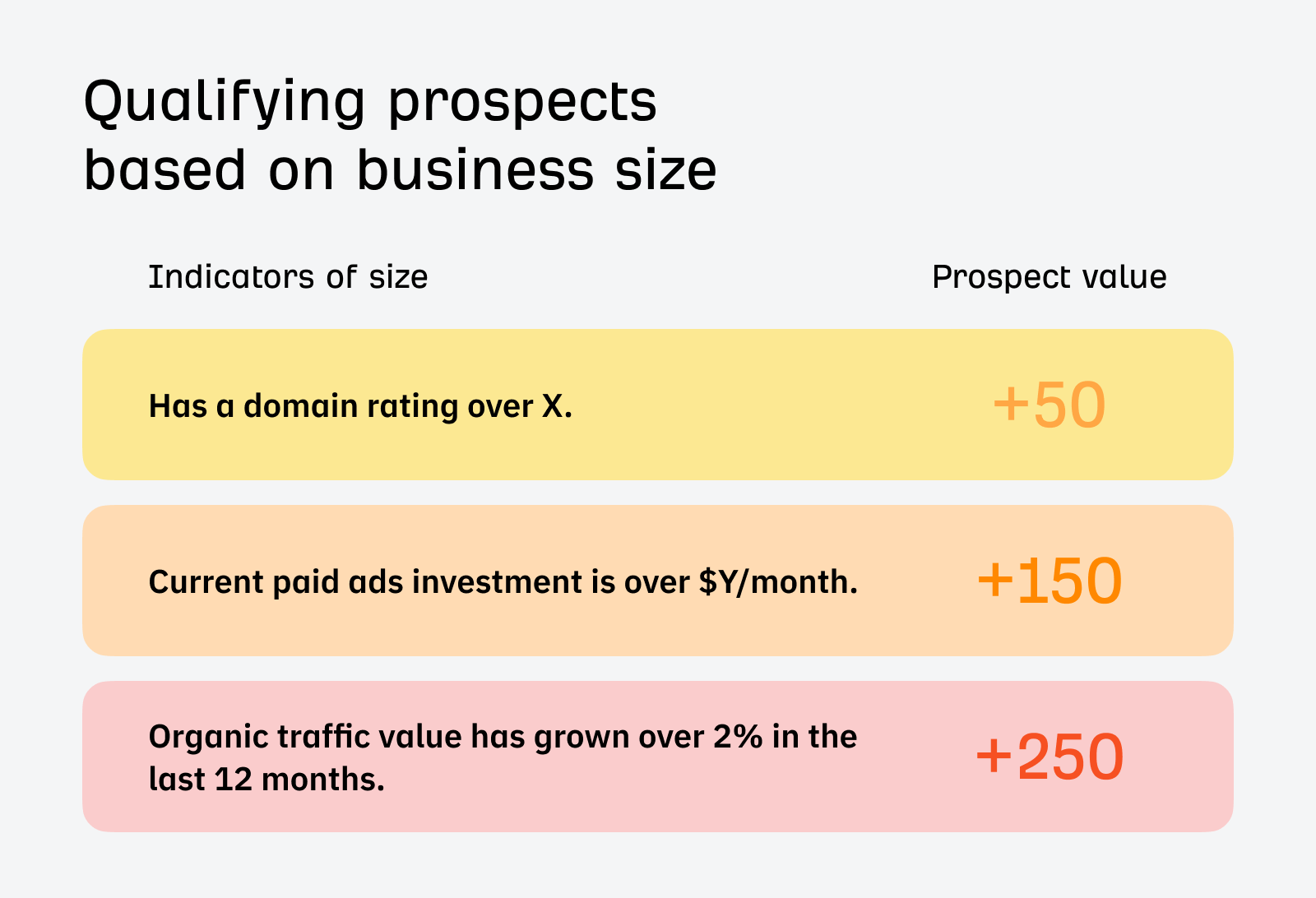
No matter the case, you can use the data available in our API to draw conclusions like the following about any prospects you’re evaluating:
- Showit is the ideal candidate for us to work with. There’s a lot of room for growth and we can make a decent impact with our competitively priced marketing services.
- WordPress is a great candidate for us to pitch our PPC services since it has the smallest spend among website-building platforms of similar size.
- Webflow may be a great candidate for our non-search marketing services. They clearly have a marketing budget for PPC and SEO, and they may also be open to investing in other channels.
Bottom line? If website performance can be used as an indicator to segment your prospects or leads, our API can help enrich your sales processes big time.
While using SEO metrics to qualify leads is one potential use case for sales teams, another is to use these metrics to help close more deals by:
- Creating data-driven case studies
- Populating data into customized sales decks
- Sharing the performance of your entire client portfolio
For example, some forward-thinking agency sales teams use our API to pull organic data across their client portfolios. They build performance dashboards that they then send to prospective clients.
And sure, at a small scale you can simply use our Portfolios feature that allows you to track multiple websites as a cohort:
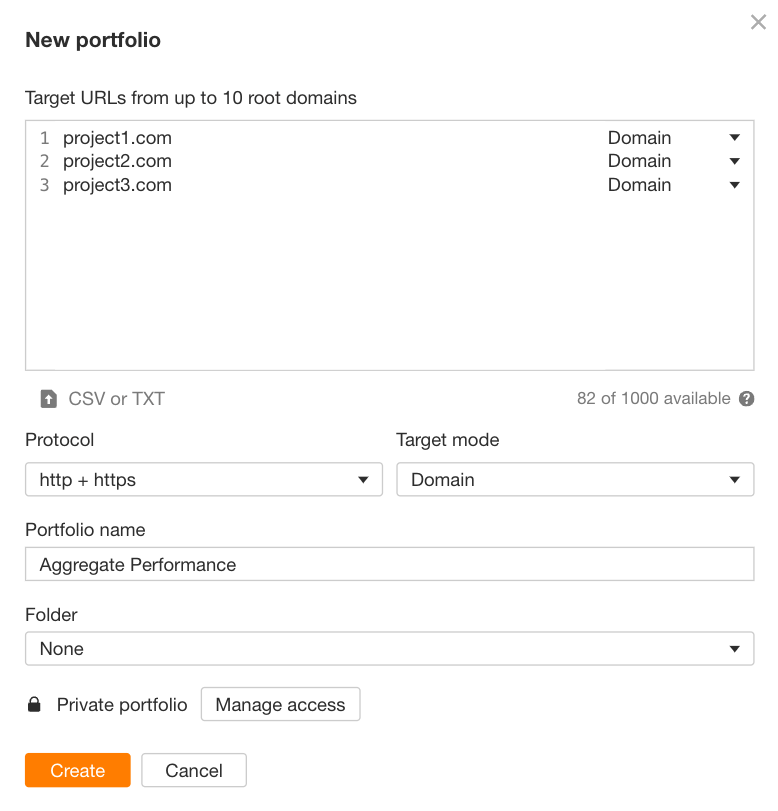
But with the API, you can aggregate more metrics and track more projects so you can display real-time results to prospective clients.
Ever wanted to say (and prove) to potential clients things like the following?
- “We’ve delivered over 10,000 position 1 rankings for our clients in the last 6 months.”
- “Six of our clients have achieved over 1 million organic visits after partnering with us.”
- “We’ve saved our clients an average of $100,000/month in ad spend.”
With our API, you can. It’s all about aggregating SEO performance metrics to help your proposals stand out from the crowd.
The global ecommerce market is forecast to hit $6.3 trillion in 2024, and with more people buying online now than ever before, digital performance data is vital for investors to be able to access in real time.
If you’re a venture capitalist, hedge fund manager, or private equity investor, you can use our API as an alternative data source to:
- Monitor online market movements
- Check your portfolio’s digital performance
- Track online performance of any company
- Be instantly notified of website traffic losses
- Inform your investment decisions
For instance, in this video, Sam looks at how the websites with the most visibility in search engines perform as a custom stock portfolio against some of the most popular assets in the world like the S&P 500, Nasdaq 100, real estate, gold, bonds, and Bitcoin.
For seasoned investors, the power of data available in our API can help take your investment decisions to the next level. You can integrate graphs from the Ahrefs dashboard directly into your tools (thanks to our nifty API button) or mix website traffic data with other data sets however you like.
For instance, let’s say you’re considering investing in a particular company. Everything looks good on paper, and you’ve been monitoring its growth over the last few months, including its website performance.
Had you not added a graph tracking their website performance in your dashboard (like the following), you may not have noticed this 25% loss of organic traffic early enough to take appropriate action:
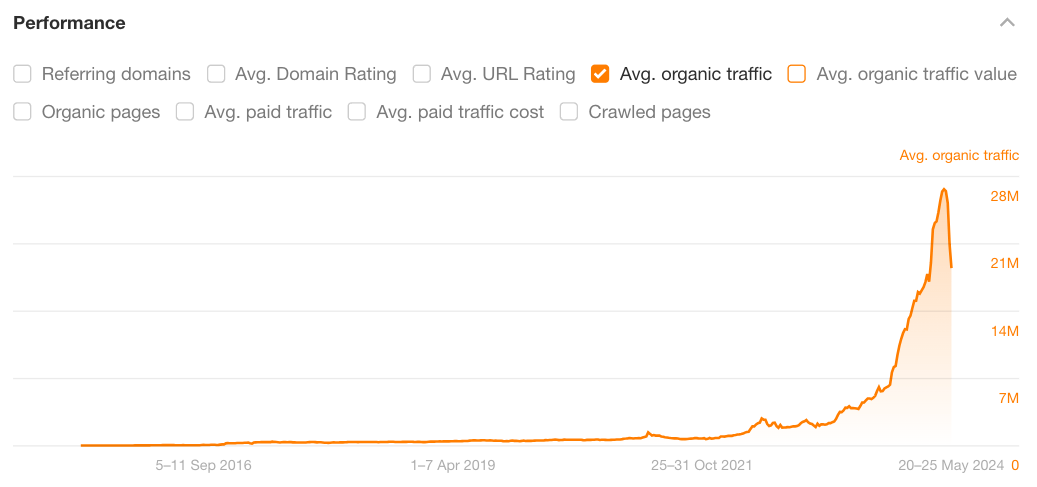
In some industries, this may not matter regarding the stock value since website visits don’t necessarily translate into purchases or company valuation. In others, it could be a deal breaker.
If multiple companies in the same vertical are experiencing similar losses in visibility, this could indicate a widespread market movement you need to know about. Traffic losses across multiple websites can also often indicate revenue losses across the industry.
For instance, this is an example of two market-leading companies in a specific vertical experiencing traffic losses at a similar time.

And here you can see their keyword ranking movements echo one another with similar rises and dips after January 2024:
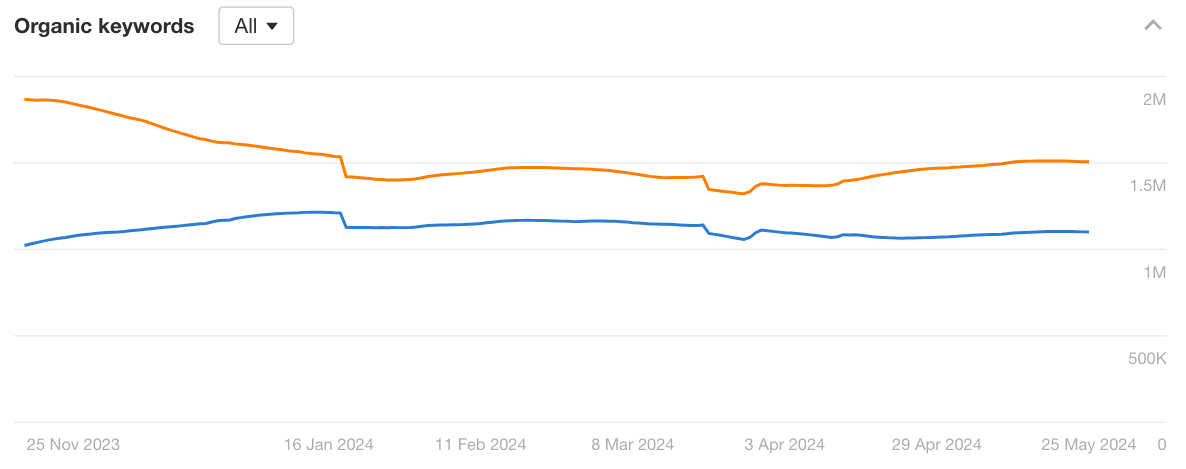
Such patterns can indicate a bigger issue affecting the entire market, not just specific companies.
The data available in our API can help you monitor widespread market movements and changes in search behaviors across any vertical you’re interested in and in real-time.
While website performance data on its own is not enough to base investment decisions on, it is a vital alternative data source to help you beat the market and mitigate potential losses.
Competitive intelligence is what Ahrefs was built for. With analytics tools and Google Search Console, you can easily find performance data about your own website. But what about competitors?
Our tool allows you to compare apples to apples when looking at competitor data. In particular, our API can help you automate things like:
- Creating competitor scorecards
- Estimating resources needed to catch up to competitors
- Monitoring competitor movements
- Gathering historical insights
- Finding and predicting untapped opportunities
For example, Patrick recently created a handful of beginner-friendly competitor scorecards that you can also take for a spin.
- General competitor scorecard
- Month-over-month competitor scorecard
- Year-over-year competitor scorecard
To use these you will need to first make a copy and add your Ahrefs API key. If you’re using the general scorecard, you’ll need to select a date (it must be the first date of a month to work). Then, add your domain and your competitors.
You won’t need to add a date with the MOM and YOY versions. Just add the API and competitor URLs.
Here’s an example of what the output will look like:

If you find yourself running competitor gap analysis reports at scale, you may also benefit from using our API to automate competitor backlink analysis and closing content gaps against top competitors.
Making projections is a core staple of enterprise SEO. It’s how executive teams are able to approve projects and allocate funding appropriately.
It’s also how agency owners set their agencies apart from competitors by adding forecasts to their sales pitches.
With our API and these free templates that Patrick has pre-built, you can:
- Predict future traffic
- Predict future traffic value
- Predict future competitor traffic
- Predict future competitor traffic value
- Predict future competitor page traffic
- Make performance predictions during a core update
- And more
Check out Patrick’s detailed post on all things to do with SEO forecasting for more ideas and tips on how to use these free templates in your business today.
Final thoughts
With the power of seriously big data on your side, the possibilities for how you can automate SEO tasks, site audits, and reports are endless.
The Ahrefs API offers many data points no other tool offers. We’ve designed it that way on purpose.
Feel free to book a demo with our enterprise team to see what our API can do for your business.



